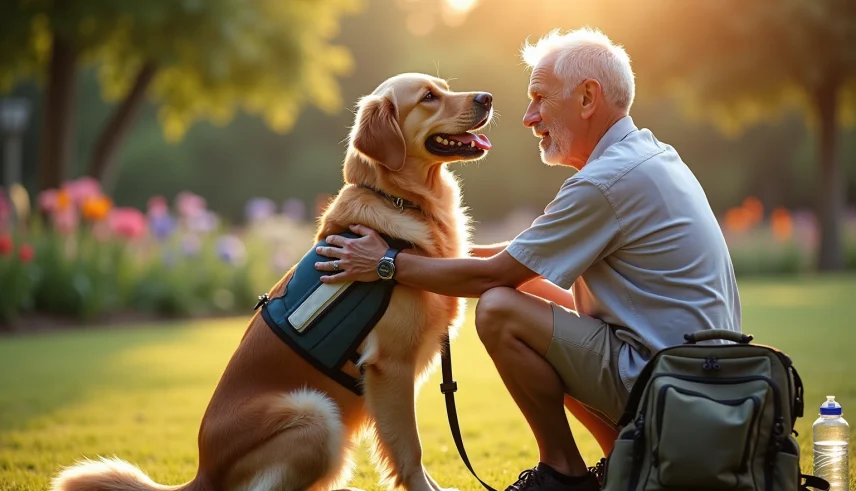
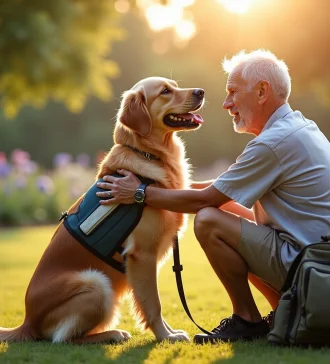
How Much Are Service Dogs for Anxiety: Key Cost Factors Explained
by Lena Park
Last updated: July 5, 2025
Verified and Approved by:
Angela Morris,
MSW, LCSW
Fact Checked

Overview
For individuals struggling with anxiety, the cost of service dogs can be a significant concern, typically ranging from $10,000 to $50,000. This wide range is influenced by various factors, including:
- The type of service dog
- The duration of training
- Breed selection
- Geographical location
It’s important to understand that these costs reflect not just the price of the dog itself but also the extensive training required to equip these loving companions with specialized skills to support those facing anxiety disorders. Additionally, there are other expenses to consider, such as veterinary care, which can add to the financial burden.
While these figures may seem daunting, it’s essential to recognize the profound impact that a service dog can have on an individual’s emotional well-being. The companionship and support provided by these trained animals can be life-changing, offering comfort and stability during challenging times. For many, exploring funding options and resources available can help ease the financial strain, allowing them to focus on the invaluable support a service dog can provide.
Introduction
The profound impact of service dogs on individuals grappling with anxiety disorders is truly significant; these specially trained companions provide essential support that can change lives for the better. Their role extends beyond simple companionship, incorporating:
- Grounding techniques
- Alerting handlers to anxiety symptoms
- Offering emotional comfort
This evolution raises an important question: how much do these invaluable animals cost? With expenses ranging from $10,000 to $50,000, potential owners face the challenge of navigating a complex landscape of factors influencing pricing, from training requirements to geographical considerations. For those seeking the unwavering support of a service dog, how can one weigh the undeniable benefits against the often overwhelming financial commitment?
Understand the Role of Service Dogs for Anxiety
Service animals for anxiety serve as specially trained companions, providing crucial support to individuals grappling with anxiety disorders such as generalized anxiety disorder, panic disorder, and PTSD. These remarkable canines engage in various activities designed to alleviate anxiety symptoms, significantly enhancing the quality of life for their handlers. Their key roles include:
- Grounding Techniques: During moments of panic, service dogs can offer grounding by maintaining physical contact, helping to soothe feelings of panic and disorientation.
- Alerting to Anxiety Symptoms: Some assistance canines are trained to detect early signs of anxiety in their handlers, alerting them before an anxiety attack escalates.
- Providing Comfort: The mere presence of an assistance dog provides emotional support, effectively diminishing feelings of loneliness and fear that often accompany anxiety disorders.
The benefits of assistance canines for anxiety are supported by data indicating that individuals with these animals experience a notable decrease in anxiety symptoms. For instance, research shows that veterans partnered with assistance animals report a 3.7-point greater reduction in PTSD symptoms compared to those with emotional support creatures. However, it’s important to recognize that 89% of assistance animal owners encounter challenges with other animals in public spaces, underscoring the difficulties they face.
Real-life stories further illustrate this impact; veterans like Tim Cleveland have shared how their assistance animals, such as Chips, have provided essential companionship and support, helping them manage anxiety and engage more fully with their communities. Tim has noted that Chips aids him in navigating social situations he once avoided due to anxiety, showcasing the profound influence a support dog can have on daily life.
Understanding these roles is vital for prospective handlers, as it highlights how assistance animals can significantly enhance emotional well-being and daily functioning for those experiencing anxiety disorders. Additionally, it’s important to acknowledge that preparing a service dog can cost between $15,000 and $30,000, which raises the question of how much are service dogs for anxiety, emphasizing the financial considerations involved in acquiring such invaluable support.
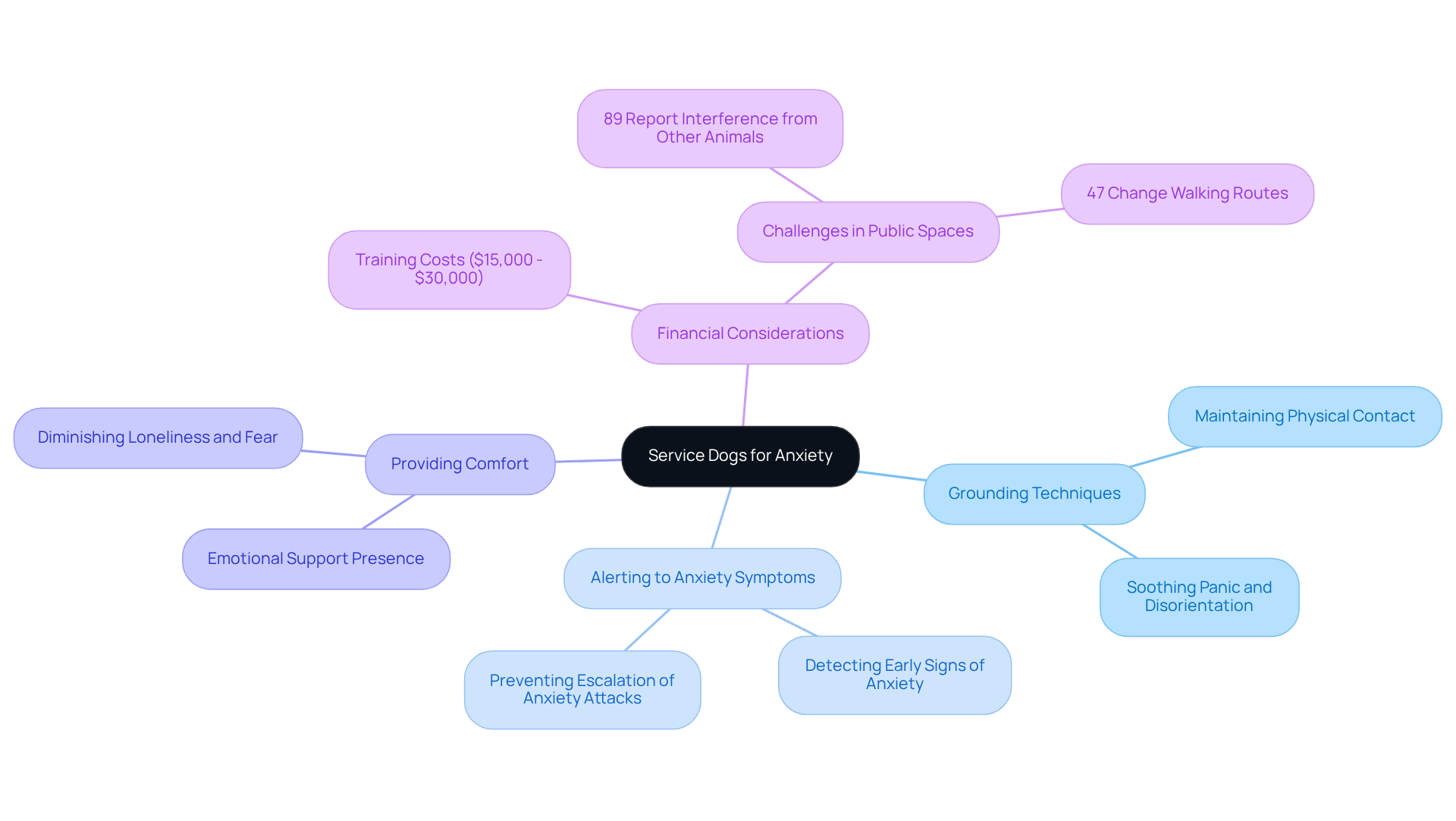
Identify Factors Influencing Service Dog Costs
The cost of acquiring a service dog can vary significantly based on several key factors that are important to consider:
-
Type of Service Dog: Different types of service dogs, such as psychiatric service dogs and mobility assistance dogs, have distinct training requirements that influence their overall costs. For instance, psychiatric assistance dogs, which provide support to individuals with anxiety, may require specialized instruction, leading to concerns about how much are service dogs for anxiety and potentially raising costs for prospective owners.
-
Duration and Intensity of Instruction: The length and complexity of the training course directly impact pricing. Training a service dog typically spans between 1 to 2 years, with expenses ranging from $10,000 to $50,000. More rigorous training tailored to specific tasks related to anxiety can lead to increased costs, raising concerns about how much are service dogs for anxiety, which may weigh heavily on the budget of those seeking assistance.
-
Breeding and Selection: The breed of the dog is crucial in determining costs. Some breeds are more suitable for assistance work due to their temperament and trainability, which can make them more expensive to acquire. Organizations often invest significantly in breeding and selecting the right dogs for these vital roles, highlighting the commitment to providing effective support.
-
Geographical Location: Prices can fluctuate based on geographical location. Urban areas often experience higher costs due to increased demand and living expenses. For example, the average wait period for a well-trained assistance dog can extend up to 3 years, reflecting both the high demand and limited supply, which can be disheartening for those in need.
-
Veterinary Costs: Substantial veterinary expenses incurred during the training of assistance dogs can accumulate to thousands of dollars, adding to the overall financial burden that potential owners must navigate.
-
Payment Options: Flexible payment plans beginning at $32.25 might be available, offering prospective assistance dog owners financial choices to consider, which can alleviate some of the stress associated with the costs.
In addition to these factors, understanding the legal rights of assistance dog owners under the Americans with Disabilities Act (ADA) is essential. Assistance animal owners enjoy complete public access rights, enabling them to bring their assistance animals into various public spaces, such as restaurants and stores. They also have the right to housing accommodations, even in places where pets are typically restricted. It is crucial to respect the working status of assistance dogs and adhere to proper etiquette when interacting with them, ensuring their effectiveness and the safety of their handlers. These legal rights and responsibilities should be factored into the budgeting process, as they can significantly influence the overall expenses and expectations for potential assistance dog owners.
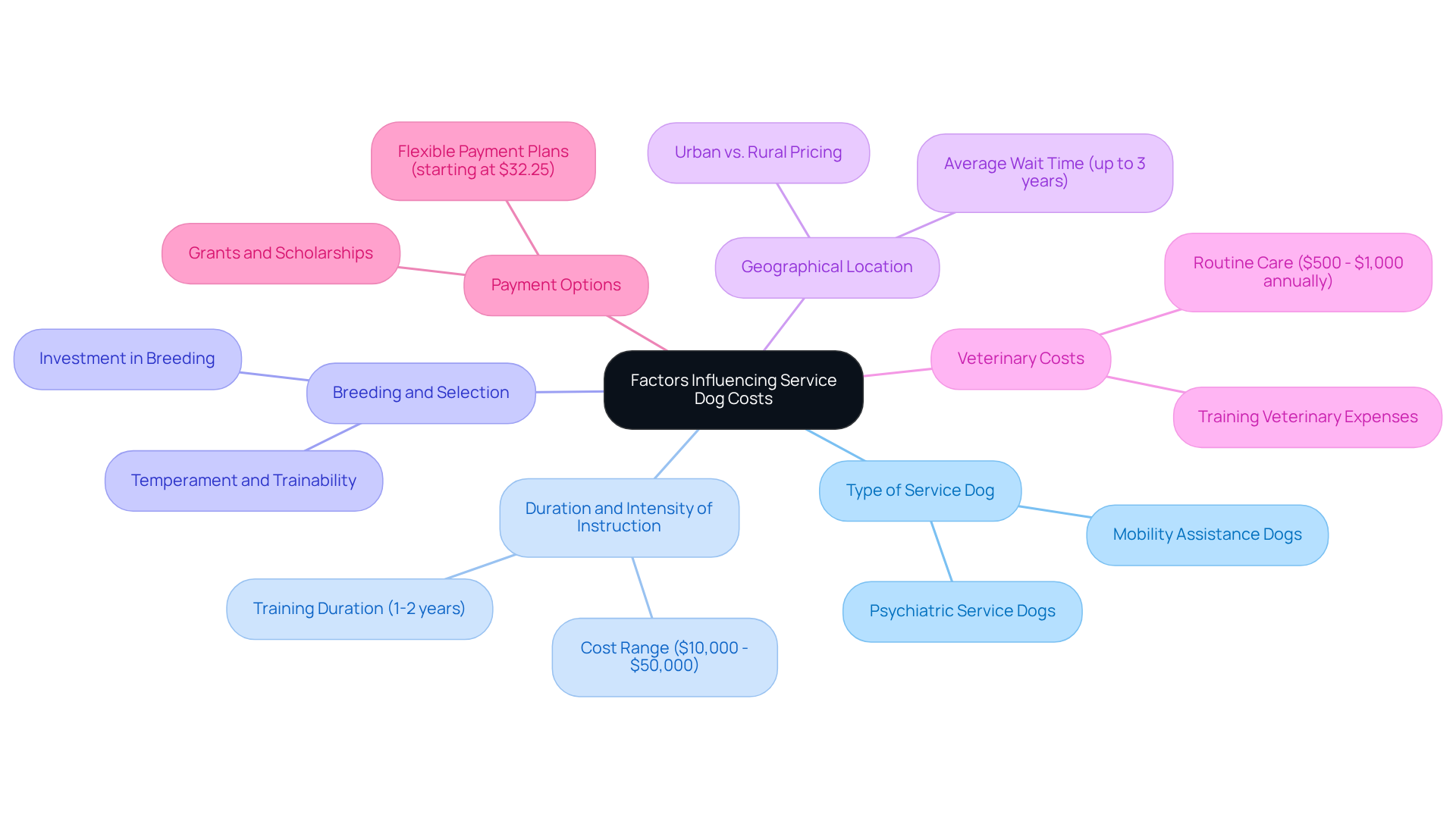
Evaluate Training Costs for Service Dogs
Training an assistance dog requires a commitment of time and effort, as well as understanding how much are service dogs for anxiety, which involves a significant financial obligation. The expenses can vary widely based on several factors, and understanding these costs can help you prepare for this important journey.
People often wonder how much are service dogs for anxiety, which typically costs between $10,000 and $50,000 to train. This variation depends on the specific developmental needs of the dog and the organization providing the training. For instance, specialized training for anxiety management may influence how much service dogs for anxiety cost, pushing expenses toward the higher end of this spectrum and reflecting the unique support these dogs can offer.
Moreover, service dogs often require continuous education to maintain their skills, which can lead to additional expenses over time. This ongoing training is vital to ensure that your dog remains effective in their supportive role. It’s important to consider these potential costs, especially since 42% of pet parents report struggling to cover unexpected vet bills, which can average between $800 and $1,500.
When deciding on training options, you might wonder about the differences between private and group instruction. Private sessions usually range from $120 to $300 per hour, offering personalized guidance tailored to both the dog and handler’s needs. On the other hand, group classes may be more budget-friendly but often lack the individualized attention that can make a significant difference in your training experience.
If your service dog needs to learn specific tasks related to anxiety management, you might want to consider how much are service dogs for anxiety, as this can further increase overall expenses. The complexity of these tasks will directly influence the duration and intensity of the training required.
By assessing these expenses, you can gain a clearer understanding of the financial commitment involved in proper training. This is particularly crucial in a world where unexpected costs can strain a pet caregiver’s budget. As you reflect on these considerations, think about your pet’s name and how you can prepare financially for this meaningful investment in their training and your well-being.
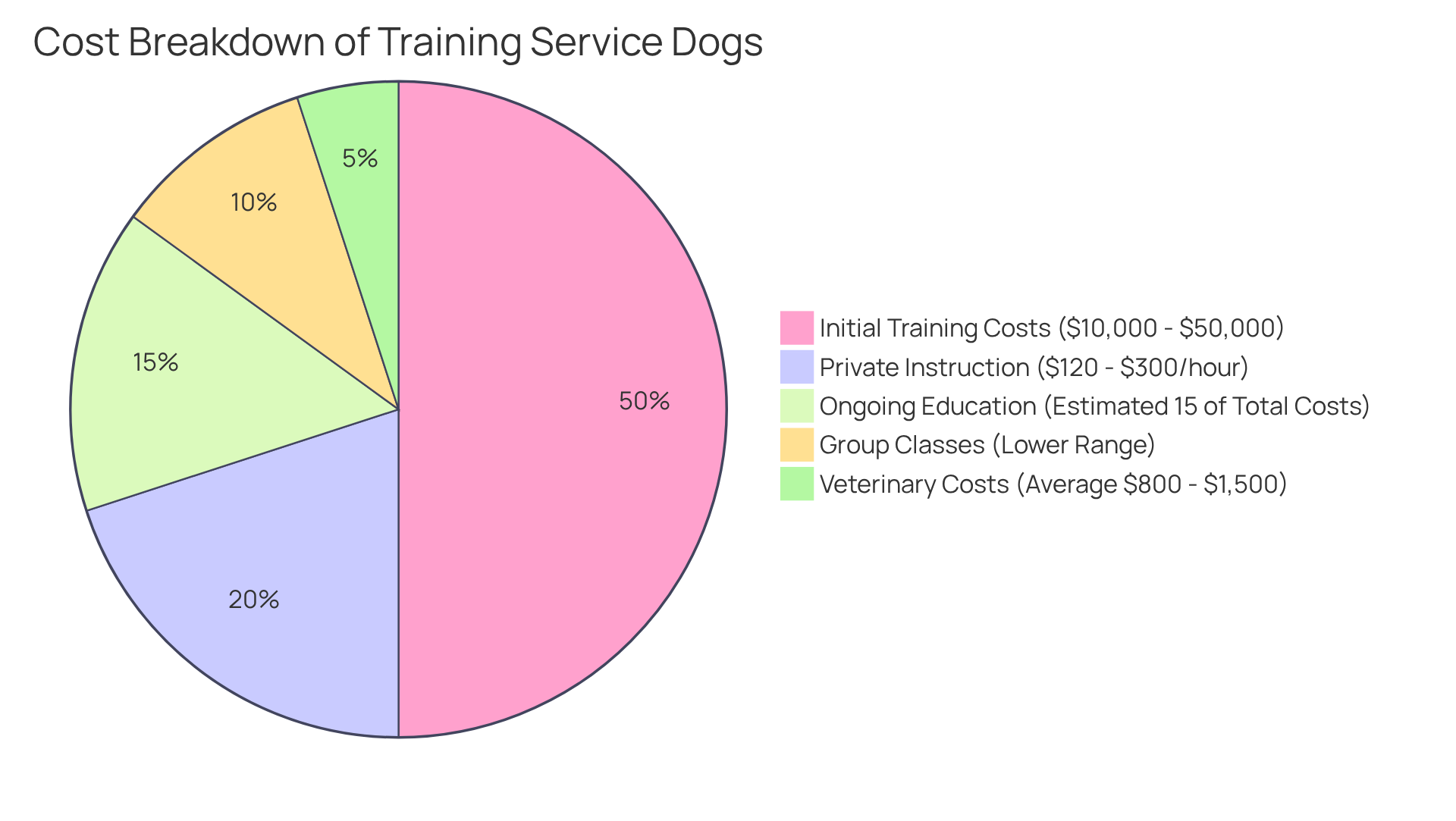
Explore Funding Options for Service Dog Expenses
When considering how much are service dogs for anxiety, it’s important to note that financing an assistance dog can be a significant financial commitment, often ranging from $20,000 to $30,000 or even more. This can feel overwhelming for many individuals. However, there are various funding options available that can help ease these costs and bring the dream of having a service dog closer to reality.
-
Grants and Scholarships: Many organizations offer grants specifically designed to support those seeking service dogs. In 2025, applicants can explore both local and national programs that provide financial assistance, including the Assistance Dogs International (ADI) Grant, which helps individuals in acquiring and training their assistance animals.
-
Crowdfunding: Platforms like GoFundMe have emerged as effective tools for raising funds. Successful campaigns often share heartfelt personal stories, inviting community support and making it easier to achieve fundraising goals. For example, individuals have organized bake sales and trivia tournaments, showcasing the incredible power of community engagement in overcoming challenges.
-
Nonprofit Organizations: Some nonprofit organizations focus on providing assistance dogs at reduced costs or even free of charge, depending on the applicant’s needs. Organizations such as Paws4People and Canines for Disabled Kids offer tailored support, enhancing the quality of life for individuals with disabilities.
-
Payment Plans: Certain training organizations provide flexible payment plans, allowing individuals to spread the costs over time. This approach can significantly alleviate financial stress, ensuring that those in need can access the vital support they require.
Exploring these funding options can help answer how much are service dogs for anxiety, making the journey toward having one more achievable for those in need, while offering essential support for mental health and overall well-being.
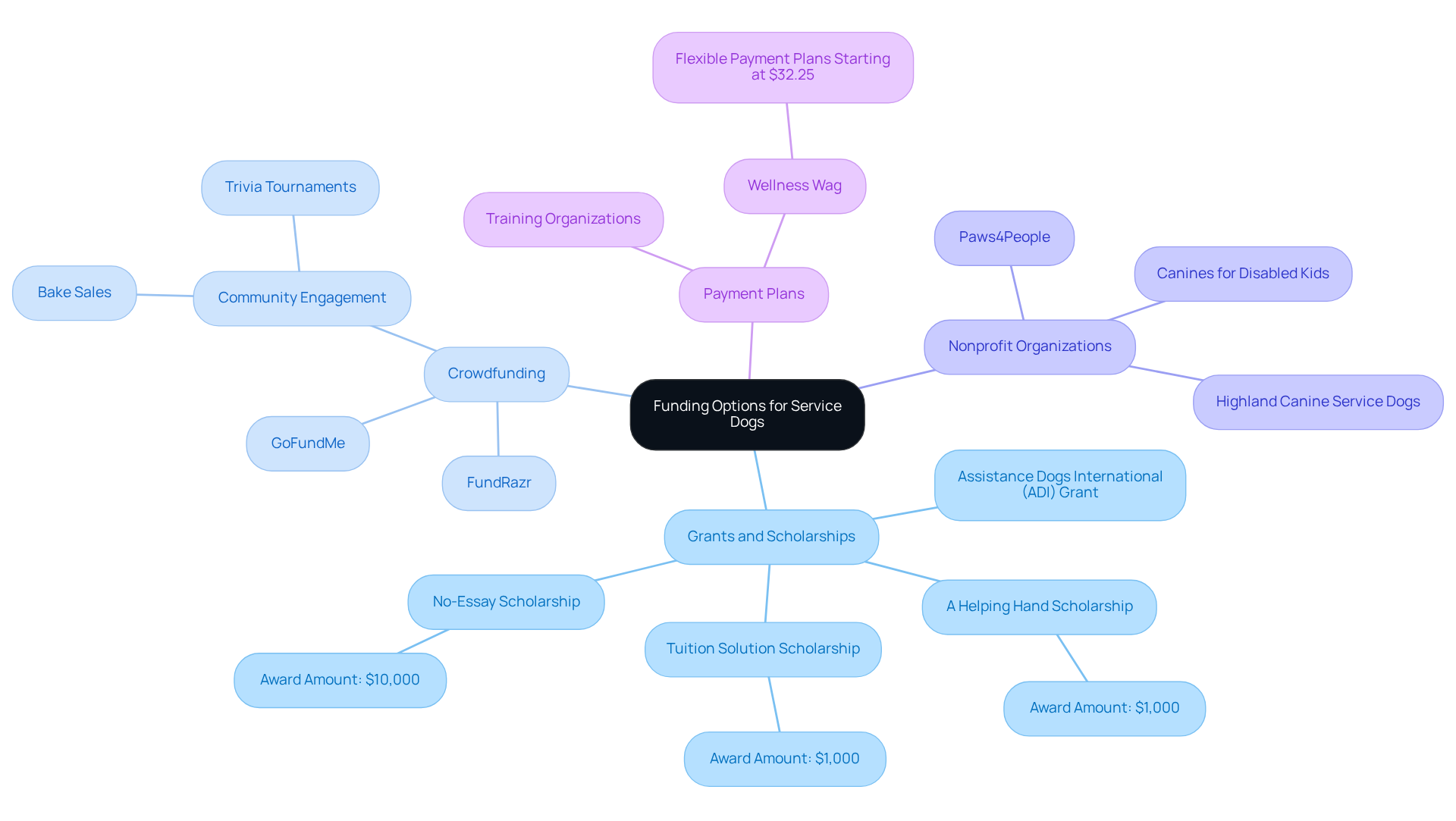
Conclusion
Service dogs for anxiety serve as a transformative resource for individuals grappling with the challenges of anxiety disorders, offering essential support that can significantly enhance their quality of life. Recognizing the multifaceted roles these remarkable animals fulfill—from providing comfort and grounding techniques to alerting handlers about impending anxiety episodes—underscores their invaluable contribution to emotional well-being. Yet, the financial implications of acquiring and training a service dog can be substantial, often ranging from $10,000 to $50,000, influenced by various factors.
Key considerations that affect these costs include:
- The type of service dog
- The duration and intensity of training
- Breed selection
- Geographical location
- Ongoing veterinary expenses
It is also crucial for potential owners to explore funding options such as grants, crowdfunding, and payment plans that can help ease the financial burden. Understanding these factors is vital, as they play a critical role in preparing for the responsibility of integrating a service dog into daily life.
Ultimately, the journey to obtaining a service dog for anxiety transcends mere financial investment; it embodies a commitment to enhancing one’s mental health and overall well-being. By delving into available resources and comprehending the associated costs, individuals can take informed steps toward securing the companionship and support that service dogs offer. This pursuit not only nurtures personal growth but also highlights the profound impact that a well-trained assistance dog can have in overcoming the challenges of anxiety.
Frequently Asked Questions
What is the role of service dogs for anxiety?
Service dogs for anxiety serve as specially trained companions that provide crucial support to individuals with anxiety disorders, such as generalized anxiety disorder, panic disorder, and PTSD. They engage in activities that alleviate anxiety symptoms and enhance the quality of life for their handlers.
How do service dogs help during panic attacks?
Service dogs help during panic attacks by offering grounding techniques, such as maintaining physical contact, which soothes feelings of panic and disorientation.
Can service dogs detect anxiety symptoms?
Yes, some service dogs are trained to detect early signs of anxiety in their handlers, alerting them before an anxiety attack escalates.
What emotional support do service dogs provide?
The presence of a service dog provides emotional support, helping to reduce feelings of loneliness and fear that often accompany anxiety disorders.
Is there evidence supporting the benefits of assistance animals for anxiety?
Yes, research indicates that individuals with assistance animals experience a notable decrease in anxiety symptoms. For example, veterans with assistance animals report a greater reduction in PTSD symptoms compared to those with emotional support animals.
What challenges do assistance animal owners face?
Assistance animal owners often encounter challenges with other animals in public spaces, with 89% reporting difficulties in these situations.
Can you provide an example of how a service dog has impacted someone’s life?
Tim Cleveland, a veteran, shared how his assistance dog, Chips, provides essential companionship and support, helping him manage anxiety and engage more fully with his community, particularly in social situations he previously avoided.
What are the financial considerations for acquiring a service dog?
Preparing a service dog can cost between $15,000 and $30,000, highlighting significant financial considerations for those seeking this type of support.
Certify Your Emotional Support Animal Today

Why You Can Rely on Us?
At Wellness Wag, we believe your pet deserves care rooted in both science and compassion. Each article is carefully researched, written in clear language for pet owners, and then reviewed by qualified professionals to ensure the information is evidence-based, current, and practical for real-life care. Our goal is to help you feel confident in making informed decisions about your pet’s health and well-being.
Reviewed by
Angela Morris, MSW, LCSW
Angela is a licensed clinical social worker with 20 years of experience in patient advocacy and community mental health. She has assisted numerous clients with ESA evaluations and brings a deep understanding of disability accommodations, ensuring that all information is accurate, supportive, and practical.

Written by :
Lena Park
Last Updated :
July 5, 2025












